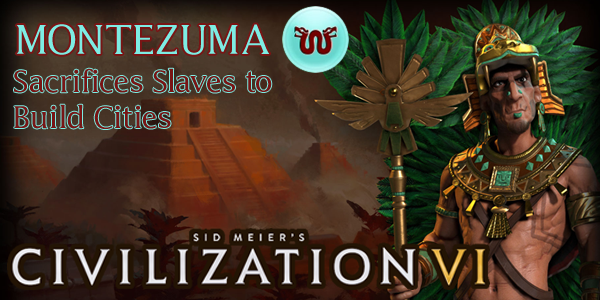
Now that I've covered all the civilizations which are new to the Civ franchise in the Gathering Storm expansion, I'm going to cover the other civs that my Patrons voted on. I'm going to start with Montezuma of the Aztecs. The Aztecs were included as DLC for the vanilla release of Civilization VI.
The Aztec Empire consisted of a "Triple Alliance" between the city states of Tenochtitlan, Texcoco, and Tlacopan in the Central Mexican Valley basin around Lake Texcoco, based largely around the cultivation of maize. They would subjugate other city states through military conquest, trade, or marriage, and then install governors to administer those client states without necessarily needing to maintain a military garrison. Client states would pay tribute directly to the Aztec emperor, who would limit their ability to communicate and trade directly with other client cities; thus, making each of the clients dependent on the empire for resources and luxury goods and reduce the likelihood of an uprising.

In the early 1500's, Spanish Conquistadors (lead by Hernán Cortéz) arrived in central Mexico and occupied the Aztec capital of Tenochtitlan, keeping Aztec Emperor Moctezuma Xocoyotzin a prisoner in his own palace. Since most of his history is depicted through the lens of the Spanish conquerors, information about Moctezuma's life and rule are limited and contradictory. He ruled the Aztec Empire at its territorial height after several successful military campaigns, and he imposed regressive policies that increased the rigidity of the Aztec caste system and severely limited the ability of commoners to work in royal palaces or ascend to nobility. Contrary to his typical depictions in the Civilization games as a blood-thirsty warmonger, contemporary Spanish writings suggest that Moctezuma may have been rather meek and was accommodating of the Spanish conquistadors, whom he invited to live in the palace as guests. Moctezuma would die during the Spanish occupation of Tenochtitlan, possibly having been stoned to death by his own citizens who were frustrated with his inability (or unwillingness) to repel the Spanish invaders.
DISCLAIMER:
Civilization VI is still a "living game". Strategies for the game (and for specific leaders and civs) may change as Firaxis applies balance patches, introduces new features, or expands the game through further DLC or expansion packs, or as the Civ community discovers new strategies or exploits. As such, the following strategy guide may change from time to time. I will try to keep it up-to-date, and will make notations whenever changes are made. I'll also post links in the official 2K forums and CivFanatics, where I'll also report any changes made. If possible and practical, I will try to retain the original content of the strategy for posterity.
I welcome any feedback or suggestions that readers wish to offer. Feel free to post on the linked forums, or by posting a comment at the bottom of the page.
This guide is up to date as of the release of the Gathering Storm expansion's "Red Death" update (ver. 1.0.0.341)
The Aztecs in Civilization VI are built to be highly aggressive, using the procurement of luxury resources to strengthen their armies and support their vast conquests.
[More]
1ebe4687-7bc0-4a01-9122-2d2756851b2b|1|5.0
Tags:Sid Meier's Civilization, Civilization VI, Aztec, Montezuma, legend of the five suns, gifts for the tlatoani, tlachtli, eagle warrior, tlatoani, luxury, amenity, war, loyalty, builder, slavery
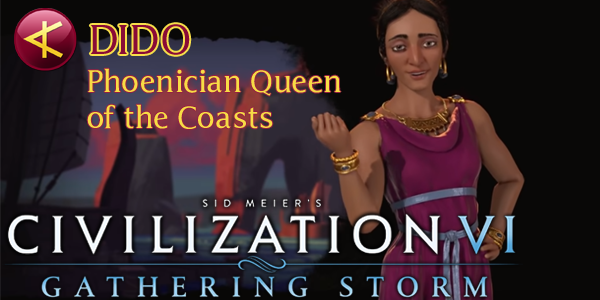
Civilization VI's second expansion, Gathering Storm released earlier this year and has added a handful of new civilizations and leaders. I am hoping to write a strategy for each of them, but I want to start with the civilizations and leaders who are completely new to the franchise. The final technically "new" civilization is Phoenicia. Phoenicia's leader, Dido has appeared in previous Civilization games as the leader of the Carthagenian civilization, but this is the first time that Phoenicia has been a civilization in the game.
Phoenicia never existed as a singular nation or empire, as the culture consisted of a collection of ancient, independent city states that built a vast Mediterranean trade network based on the export of dates, purple dyes, and textiles. The cities of Tyre, Byblos, and Sidon, on the Mediterranean coasts of modern-day Lebanon and Israel made up the core of the civilization, but colonies reached as far as Carthage in northern Africa and Cadiz in Spain. Phoenician ships were among the first to sail beyond the Strait of Gibraltar and begin exploring the Atlantic Ocean, and some fringe historians suggest that ancient Phoenicians may have made it as far as the southern tip of Africa, and maybe even to the Americas (though this is highly speculative).
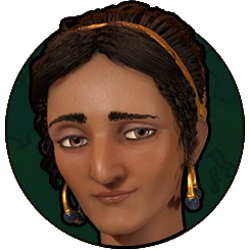
Dido is a semi-mythological figure who is regarded as the Mother of Carthage. Most historians agree that Dido existed, that she fled Tyre after a power struggle with her brother Pygmalion, and that she founded the cities of Byrsa and Carthage. There is, however, considerable disagreement about when and how it all happened. According to Virgil's Aeneid, Dido falls in love with Aeneas in Carthage after Aeneas flees the sacked city of Troy (much to the dismay of the Berber king who sought her hand in marriage). Aeneas is ordered by the god Mercury to leave Dido and settle in Italy, which he reluctantly does, and his sons Romulus and Remus would go on to found the city of Rome. Dido kills herself on a pyre and curses the descendants of Troy, thus establishing the rivalry between Rome and Carthage and foreshadowing the Punic Wars that ultimately resulted in the destruction of Carthage. Some traditions even say that Dido continues to haunt Aeneas forever in the underworld. This story contradicts the other accounts of Dido's death, in which Aeneas is never referenced, and Dido killed herself in the Pyre in order to escape marriage to the Berber King and remain faithful to her first husband. The truth is probably forever lost to the sands of time.
DISCLAIMER:
Civilization VI is still a "living game". Strategies for the game (and for specific leaders and civs) may change as Firaxis applies balance patches, introduces new features, or expands the game through further DLC or expansion packs, or as the Civ community discovers new strategies or exploits. As such, the following strategy guide may change from time to time. I will try to keep it up-to-date, and will make notations whenever changes are made. I'll also post links in the official 2K forums and CivFanatics, where I'll also report any changes made. If possible and practical, I will try to retain the original content of the strategy for posterity.
I welcome any feedback or suggestions that readers wish to offer. Feel free to post on the linked forums, or by posting a comment at the bottom of the page.
This guide is up to date as of the release of the Gathering Storm expansion's "September 2019 update" (ver. 1.0.0.341)
I debated with myself about whether to write a guide for Dido at this time, since I've already written a guide for her in Civ V, but I decided to go ahead and cover Phoenicia because it and Dido have some unique abilities that I was curious to play around with, and Firaxis added a new map type that potentially works well with her abilities. Dido is the only leader in Civilization VI who is allowed to willingly move her capital, and moving that capital actually does have some utility within the game.
[More]
1edd6e20-1d8b-42a9-961a-d8ff62814c56|0|.0
Tags:Sid Meier's Civilization, Civilization VI, Civilization VI: Gathering Storm, Phoenicia, Dido, Mediterranean colonies, founder of Carthage, cothon, bireme, Sicilian wars, navy, continent, palace, government plaza, trade routes, colonies, loyalty, ocean
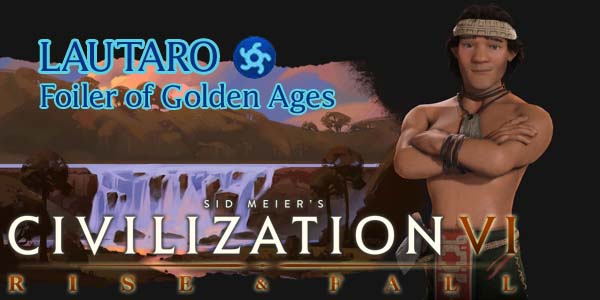
Civilization VI's first expansion, Rise & Fall released earlier this year, and it introduced a few leaders and civilizations that are making their first appearance in the franchise. I hope to be able to write strategies for every one of the expansion civs and leaders, but I'm going to start with the ones that are new to the franchise, and the ones that most utilize the expansion's new features (Era Score, governors, loyalty, and so on). This month, I will be tackling the Mapuche, lead by Lautaro.
The peoples known as the Mapuche are a collection of societies indigenous to southern Chile and Argentina who are linked by social, spiritual, economic, and linguistic heritage. Archaeological evidence shows their culture has existed since around 600 or 500 BC, and their textiles have been traded throughout South America for centuries. Though mostly independent, the various tribes would unite together during times of war (such as against the Inca and Spanish) and elect a "toqui" (meaning "axe-bearer") to act as a military and domestic leader.

One such toqui was Lautaro "Swift Hawk". He was elected toqui while still less than 20 years old, after escaping from the personal captivity of the Spanish general Pedro de Valdivia. He lead numerous successful raids (called "Malón") against the Spanish, eventually capturing Fort Tucapel in December and killing his former captor, de Valdivia, during the Spanish counterattack in December 1553. The Mapuche, under Lautaro's command, may have been able to further expel the Spanish if not for a typhus outbreak and famine that prevented further raids. He was killed four years later in a Spanish ambush, but the Mapuche would continue to resist the Spanish for over a century after Lautaro's death. Lautaro is revered by Chileans (Mapuche and non-Mapuche alike) for his courageous leadership against the Spanish who sought to enslave them, and is even depicted as an almost heroic figure in the Spanish epic poem La Araucana.
Lautaro and the Mapuche can be a potent military force in Civilization VI: Rise & Fall, especially against rival civilizations that ascend to golden ages, or who fall into dark ages.
[More]
a95ca795-d055-4cea-94db-0c1f2aeff1de|0|.0
Tags:Sid Meier's Civilization, Civilization VI, Civilization VI: Rise and Fall, Mapuche, Lautaro, Toqui, Swift Hawk, Spirit of Tucapel, Malon Raider, Chemamull, loyalty, golden age, dark age, culture, appeal, tourism, cavalry, light cavalry, pillage, Chile, unique improvement, unique mounted unit
Almost a decade ago, my love of board-gaming was kick-started by a single game. That game was Fantasy Flight's Battlestar Galactica board game. For a period of a couple years, my friends and I were playing that game once or twice almost every month. Even after we started branching out to other games, BSG would regularly grace our tables.
The Battlestar Galactica board game kick-started my tabletop hobby.
Unfortunately, as time went on, members of the regular group(s) that I played with got new jobs, moved, started families, and it became harder and harder to get a large enough group together to play a 4 or 5-hour long board game. Eventually, BSG (along with all my other games) started collecting dust on a shelf.
It wasn't until a few years ago that I finally got back into having semi-regular board game sessions, thanks primarily to my girlfriend taking an interest in X-Wing. Most of our board gaming in the past years has been dominated by either quick group games (such as Dominion, One Night Ultimate Werewolf, Resistance, or Cards Against Humanity), or smaller, two-player games (like the aforementioned X-Wing). No one game has dominated in quite the same way that BSG did. I'd like to play it again, and maybe someday I'll even put up a review of it, but we haven't dusted the ol' game off because we rarely have the time for it. When we do have a whole evening cleared for an epic game, we try to play other games that we haven't already played the hell out of.
Well, clearly, I wasn't the only one who loved Battlestar Galactica, but wished it didn't take so bloody long to play, because Evan Derrick's 2011 game Dark Moon is basically a reskin of Battlestar Galactica that only takes an hour and a half to play. Dark Moon accomplishes this by reducing a lot of the mechanical complexity and by making progress in the game a lot more straight-forward. Virtually every mechanic or interaction in Dark Moon is a direct analog to a mechanic or interaction in BSG.
The shape-shifting space monster among us
The core conceit of Dark Moon (and Battlestar Galactica) is that the game is a semi-cooperative game in which most of the players are working together to try to prevent their moon-based mining station from falling apart around them. However, one or more of the players is secretly a shape-shifting alien (an "infected") who is trying to sabotage the station and kill all humans. Players take turns performing a single action to try to stabilize the deteriorating mining station. However, the most efficient action is to "issue an order" to another player to allow that player to take multiple actions. The catch is that the player you give the order to may secretly be a saboteur, so you have to be careful about only giving orders to other players who you trust.
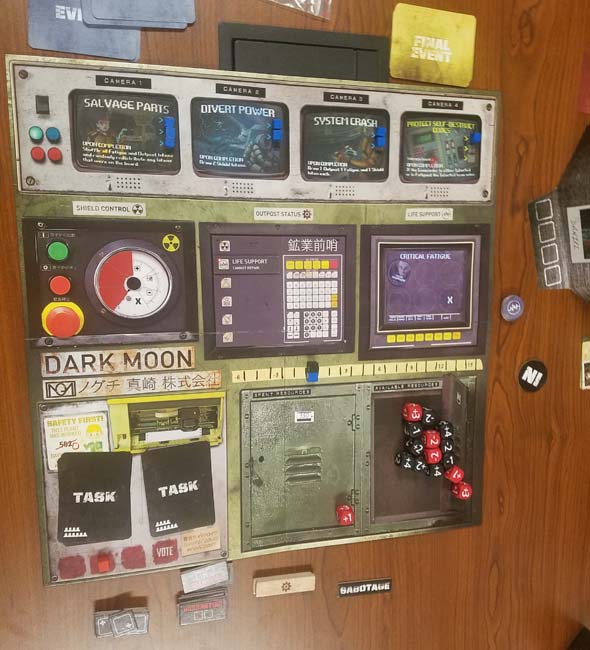
Players cooperate to complete a series of events, but some players are secretly traitors.
At the end of each player's turn, the entire group participates in a group task. Each task card has a pass or fail condition. Passing may result in positive effects for the uninfected players, and failing may result in harmful effects. These group tasks ensure that every player gets to participate in virtually every turn, so you're never sitting around twiddling your thumbs waiting for other players to do things. Even if you weren't participating in the turn, it would still behoove you to pay close attention to what's going on, if for nothing else than to look for any tells or indications that the current player may be an Infected... [More]

When Civilization V first launched back in 2010, it was in a pretty ugly, incomplete state. The game was buggy, was very slowly-paced, was completely missing any sort of espionage mechanic, and had other gaping holes in its design. It took about six or eight months' worth of patching and updating from Firaxis before the game reached a state that I would consider "adequate". Its first expansion, Gods & Kings basically came off as a fan wishlist, as it re-added (and re-vamped) many of the features and systems that had been removed between Civ IV and Civ V (religion and espionage). That expansion also addressed a lot of core complaints with the game by dramatically improving combat balance and A.I. intelligence. The second expansion, Brave New World, almost completely re-invented the game and added a considerable amount of innovation in the form of trade routes and the new great works and artifacts systems. It also added an exceptional, robust roster of new civilizations.
Civilization VI launched with most of Brave New World's innovations still in place (though culture seems to have regressed a bit), and also added its own new innovations in city management. It felt like a much more complete game at launch than Civ V was. At the time, I was blown away by Civ VI, but as time has gone by (and I've increased the difficulty level), my enthusiasm for the game has diminished a bit.
I really enjoy the game when I play it on the King difficulty level (the "easiest" of the "hard" difficulty levels, in which A.I.s only get very slight bonuses). As soon as I up the difficulty to Emperor, I start to get frustrated, and the game becomes much less fun. The problem is that on the difficulty that I enjoy (King), the A.I. puts up very little resistance, and the game (though fun) is generally too easy. I can play the game on Emperor (I haven't experimented much on Immortal or higher in VI yet), but the stacking of the deck makes the game less enjoyable because I often feel that I'm blocked out of many early-game strategies that I want to try (such as early religion or wonders). It's all possible to accomplish, but it's prohibitively so, and the game often pushes me too far in the direction of militancy.
Doesn't address core game issues
Nope. Still no build queue...
In summary, while Civilization V's first expansion filled many of the gaping holes and addressed many of the flagrant flaws in vanilla Civ V's design, VI's first expansion mostly just stacks additional mechanics and features onto an already-complete game, while leaving many of VI's annoyances, quirks, and genuine flaws un-resolved. Let's get these complaints out of the way first.
Rise and Fall does little to address complaints with shallow unit upgrade paths. There's still generally only a single unit of a given unit class every other era.
Rise and Fall does very little to improve the combat systems in general. Units still die far too easily (in my opinion) (though this seems to be due in large part to the disparity in unit upgrade levels mentioned above), and imbalances between melee, ranged, and mounted units are still prevalent.
Rise and Fall does nothing to address complaints that I've had with the maps feeling very crowded and claustrophobic.
Civilization VI back-loads most of its culture, tourism, artifact, and great work systems into the second half of the game, and Rise and Fall does very little to make these feel like game-long engagements the way that Brave New World mostly did.
It does very little to make the late-game victory march feel less like a slog, or to make the early-game feel less rushed (especially on higher difficulties).
It does very little to address complaints with how the A.I. agendas can make them very erratic and schizophrenic. A.I.s are still far too willing to agree to joint wars against their own friends, allies, and trade partners, and joint wars in general still feel like a cheap loophole that lets warmongers bypass the casus belli system and warmonger penalties. Further, while the expansion does allow for deeper alliances with mutual benefits for the civs involved, it does not expand alliances to the point of allowing for shared or cooperative victories. So dipomacy in general still feels like a zero-sum-game with every civ acting to the exclusion of all others.
There's still no icon or indication that a unit has experience bonuses from barracks or buffs such as "Spears of Fion", or to indicate which abilities or penalties a given unit has by default.
We still can't assign military units to escort traders, nor can we see the path of any particular trader after it's started a route. And Trade routes themselves still don't generate reciprocal profit by default, meaning there's no reason to want other civs to send routes to you (other than getting a free road out of it, which isn't all that rewarding).
There's also still no build queues for cities!
Religion was overhauled in a patch last year, and religious units occupy their own layer.
Some major game upgrades have already been made available via post-release patches and DLC updates, and I'm grateful for those. New resources and wonders have trickled in since launch. One of the best improvements came in an update last year that allowed religious units to exist on their own layer, so that swarms of missionaries don't block your own units' movement in your territory. And the religious system in general was improved. So the game, overall, has improved a little bit since release. It just hasn't improved as dramatically as Civ V had improved in its first year. Though, to its credit, Civ VI didn't have as much room for obvious improvement. [More]
632a8ce2-8692-4ca9-aebc-779064580062|0|.0
Tags:Sid Meier's Civilization, Civilization IV, Civilization VI: Rise and Fall, strategy, history, dark age, golden age, loyalty, emergency, alliance, Cree, Poundmaker, Dutch, Netherlands, Wilhelmina. Georgia, Tamar, Chandragupta, India, Korea, Seondeok, Mongolia, Genghis Khan, Scottish, Robert the Bruce, Mapuche, Lautaro, Zulu, Shaka
|

| 12 | | | | | | | 60 | | 11 | | | | | | | 55 | | 10 | | | | | | | 50 | | 09 | | | | | | | 45 | | 08 | | | | | | | 40 | | 07 | | | | | | | 35 | | 06 | | | | | | | 30 | | 05 | | | | | | | 25 | | 04 | | | | | | | 20 | | 03 | | | | | | | 15 | | 02 | | | | | | | 10 | | 01 | | | | | | | 05 |
|